Prices in AUD. Shipping worldwide. Flat rate $8 postage per order within Australia. International by weight calculated at checkout. Read full terms.
-
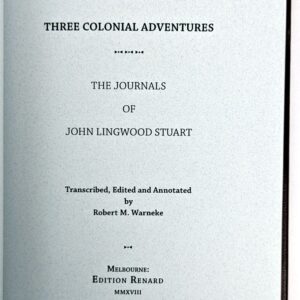
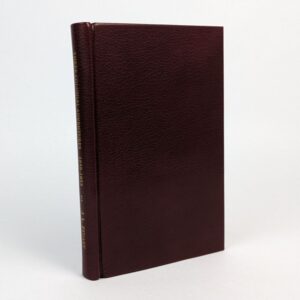
Three Colonial Adventures
AU$285.00 Read MoreAdd to cartJohn Lingwood Stuart
Melbourne: Edition Renard, 2018.One of the Deluxe Edition of 70 numbered copies in full leather (from a total edition of 215). John Lingwood Stuart’s three manuscript journals, here collected under the title THREE COLONIAL ADVENTURES, have never before been published. Written in 1849, 1851, and 1852-53 they provide a fascinating insight into the migration of a young man from England to Adelaide in South Australia and his subsequent adventures in his new land. His first journal comprises an interesting shipboard diary of his voyage to Australia on board the Minerva. Whilst not a particularly remarkable voyage in itself, his journal captures beautifully the experience of a migrant in the mid-nineteenth century, conveying with gentle humour just what it was like to be a passenger in those times, the routine, the duties, the boredom, the occasional excitement, the wildlife observed, the sickness and (fortunately few) deaths, and of course, the weather. His second journal is much more unusual and historically important. In 1851 Stuart signed on to a sealing expedition in South Australian and Kangaroo Island waters on the cutter Jane and Emma and he gives a detailed daily account of the progress of the voyage, the places visited, seals killed, skins and oil obtained, other wildlife observed, and encounters with sailors, settlers, and Aborigines. Following his return to Adelaide, in 1852 Stuart embarked on another expedition, this time overland by bullock dray to the diggings at the Bendigo goldfields. Again, historically important, and one of the few detailed journals of the time, Stuart recounts his adventures following the Murray and Loddon Rivers including comments on the squatters and Aboriginal people encountered along the way, the difficulties of travelling with bullocks and much else. Arriving at Bendigo he and his companions spent a few days investigating various gullies before commencing digging in Geelong Gully where almost immediately they found gold. All three journals have dated daily entries and have been meticulously transcribed, but the wealth of interesting information has been hugely supplemented by the detailed and informative footnotes and the account of Stuart’s life (he subsequently became a mining engineer) by Robert M. Warneke. In addition Robert has provided maps of the two Australian journeys, carefully reconciling the places mentioned by Stuart to the geography; a detailed analysis of the seal catch and notes to the wildlife encountered in all three journeys; and an extensive bibliography of the references used. A detailed description of the original journals is provided by Julien Renard. An entirely new and original work, never before published, elegantly typeset with sparing and judicious use of colour to enhance the text and capture the flavour of the manuscript originals, and the volumes have been finely hand bound by Peter Lewis.
-
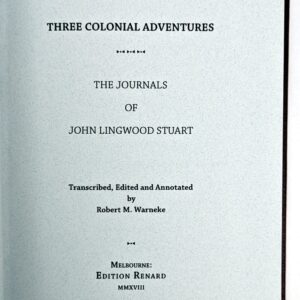
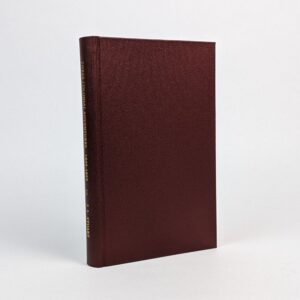
Three Colonial Adventures
AU$175.00 Read MoreAdd to cartJohn Lingwood Stuart
Melbourne: Edition Renard, 2018.One of the Standard Edition of 100 numbered copies (from a total edition of 215). John Lingwood Stuart’s three manuscript journals, here collected under the title THREE COLONIAL ADVENTURES, have never before been published. Written in 1849, 1851, and 1852-53 they provide a fascinating insight into the migration of a young man from England to Adelaide in South Australia and his subsequent adventures in his new land. His first journal comprises an interesting shipboard diary of his voyage to Australia on board the Minerva. Whilst not a particularly remarkable voyage in itself, his journal captures beautifully the experience of a migrant in the mid-nineteenth century, conveying with gentle humour just what it was like to be a passenger in those times, the routine, the duties, the boredom, the occasional excitement, the wildlife observed, the sickness and (fortunately few) deaths, and of course, the weather. His second journal is much more unusual and historically important. In 1851 Stuart signed on to a sealing expedition in South Australian and Kangaroo Island waters on the cutter Jane and Emma and he gives a detailed daily account of the progress of the voyage, the places visited, seals killed, skins and oil obtained, other wildlife observed, and encounters with sailors, settlers, and Aborigines. Following his return to Adelaide, in 1852 Stuart embarked on another expedition, this time overland by bullock dray to the diggings at the Bendigo goldfields. Again, historically important, and one of the few detailed journals of the time, Stuart recounts his adventures following the Murray and Loddon Rivers including comments on the squatters and Aboriginal people encountered along the way, the difficulties of travelling with bullocks and much else. Arriving at Bendigo he and his companions spent a few days investigating various gullies before commencing digging in Geelong Gully where almost immediately they found gold. All three journals have dated daily entries and have been meticulously transcribed, but the wealth of interesting information has been hugely supplemented by the detailed and informative footnotes and the account of Stuart’s life (he subsequently became a mining engineer) by Robert M. Warneke. In addition Robert has provided maps of the two Australian journeys, carefully reconciling the places mentioned by Stuart to the geography; a detailed analysis of the seal catch and notes to the wildlife encountered in all three journeys; and an extensive bibliography of the references used. A detailed description of the original journals is provided by Julien Renard. An entirely new and original work, never before published, elegantly typeset with sparing and judicious use of colour to enhance the text and capture the flavour of the manuscript originals, and the volumes have been finely hand bound by Peter Lewis.
-
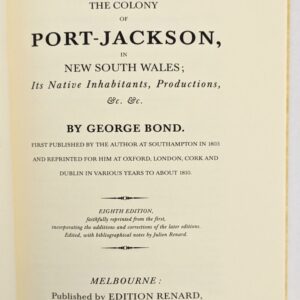
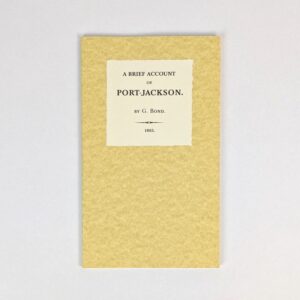
A Brief Account of the Colony of Port-Jackson,
AU$75.00 Read MoreAdd to cartGeorge Bond; Julien Renard
Melbourne: Edition Renard, 2005.in New South Wales; Its Native Inhabitants, Productions, &c. &c. By George Bond. First published by the Author at Southampton in 1803 and reprinted for Him at Oxford, London, Cork and Dublin in various Years to about 1810. Eighth Edition, faithfully reprinted from the first, incorporating the additions and corrections of the later editions. Edited, with bibliographical notes by Julien Renard. Limited Edition of 100 copies within a total edition of 200 numbered copies, and now first published since about 1810. All the original editions are of great rarity. No copies of the 2nd or 3rd editions have been recorded and the first (Southampton, 1803) edition is extremely rare, while the 4th (Oxford, 1806), 5th (London, 1809), 5th (i.e. 6th, Cork, undated), and 6th (i.e. 7th, Dublin, also undated), editions are all very rare. The work is of considerable importance as one of the few accounts of Hunter’s period as Governor. Hunter was dissatisfied with Bond’s behaviour in the colony and complained of him in dispatches. Hunter was instructed to return him to England and Bond left the colony under a cloud in 1800, but his narrative was evidently very popular. He gives an account of the operation of the convict system and the economic corruption in the colony, and describes early efforts to encourage free settlers. He includes also comments on the Aborigines and on the natural history of the colony, including much from first-hand experience. See FERGUSON 480; WANTRUP, pp. 91-3.
-
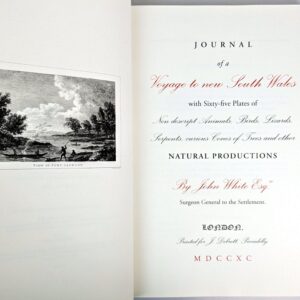
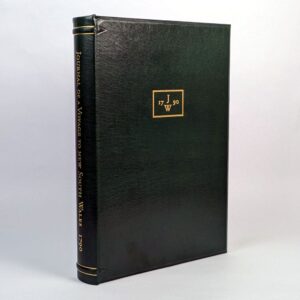
Journal of a Voyage to New South Wales
AU$3,250.00 Read MoreAdd to cartJohn White
Melbourne: Edition Renard, 2002.Edition of 212 numbered copies, 200 only for sale, this being one of 40 deluxe copies with the plates in both coloured and uncoloured states. This sumptuous new edition is reprinted with the text entirely reset in Garamond, attractively printed in black, red, and green, and the plates enlarged by 50%. The plates, by Sarah Stone, F. P. Nodder, and other fine artists comprise 29 of birds (including splendid parrots), 10 of reptiles and amphibians, 7 mammals (marsupials and the Dingo), 6 of fishes, 9 of plants (including magnificent Banksias), 2 of invertebrates, and 2 of Aboriginal weapons and artefacts. In the original edition the leaf Hh4 is cancelled in some copies with a variant text describing in the cancelled state a description of the Wattled Bee-Eater, or Merops, Female and in the uncancelled state a description of the male bird. Both texts have been reproduced here and there are some bibliographical and publishing notes appended. This was the first natural history book on Australia of any significance to be published after the arrival of the First Fleet and has never before been republished with the plates in colour. Edition Renard was awarded two Gold Medals at the 20th National Print Awards, and a Certificate of Manufacturing Excellence of the Victorian Manufacturers Hall of Fame for this book, the first publication under the imprint.
-
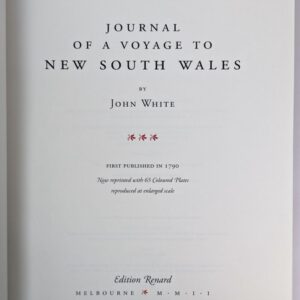
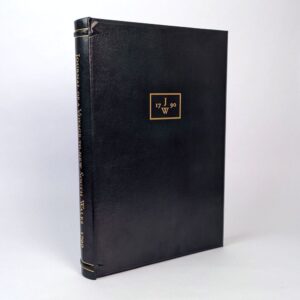
Journal of a Voyage to New South Wales
AU$2,375.00 Read MoreAdd to cartJohn White
Melbourne: Edition Renard, 2002.Edition of 212 numbered copies, 200 only for sale, this one of 150 numbered copies of the Standard Edition. This sumptuous new edition is reprinted with the text entirely reset in Garamond, attractively printed in black, red, and green, and the plates enlarged by 50%. The plates, by Sarah Stone, F. P. Nodder, and other fine artists comprise 29 of birds (including splendid parrots), 10 of reptiles and amphibians, 7 mammals (marsupials and the Dingo), 6 of fishes, 9 of plants (including magnificent Banksias), 2 of invertebrates, and 2 of Aboriginal weapons and artefacts. In the original edition the leaf Hh4 is cancelled in some copies with a variant text describing in the cancelled state a description of the Wattled Bee-Eater, or Merops, Female and in the uncancelled state a description of the male bird. Both texts have been reproduced here and there are some bibliographical and publishing notes appended. This was the first natural history book on Australia of any significance to be published after the arrival of the First Fleet and has never before been republished with the plates in colour. Edition Renard was awarded two Gold Medals at the 20th National Print Awards, and a Certificate of Manufacturing Excellence of the Victorian Manufacturers Hall of Fame for this book, the first publication under the imprint.
-
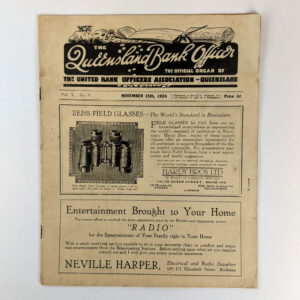
The Queensland Bank Officer: The Official Organ of the United Bank Officers Association, Queensland (Vol. V., No. 9. November 15th, 1924)
AU$30.00 Read MoreAdd to cartThe United Bank Officers’ Association of Queensland
[Brisbane]: The United Bank Officers’ Association of Queensland, 1924. -
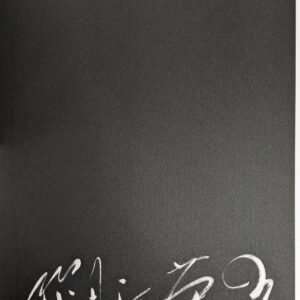
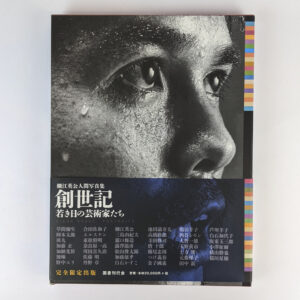
Soseiki: Wakaki hi no geijutsukatachi / Eikoh Hosoe Portraits
AU$450.00 Read MoreAdd to cartEikoh Hosoe
Tokyo: Kokusho Kankokai, 2012.125 mostly previously unpublished portraits of 35 of Japan’s leading 20th century artists in their youth. Features butoh dancers, writers, artists, and creatives such as Yayoi Kusama, Yukio Mishima, Kazuo Ohno, Tatsumi Hijikata, Min Tanaka, Akira Sato, Yoko Ashikawa, Masuo Ikeda, Shuji Terayama, and others. Limited to 1,500 unnumbered copies, this copy signed by Eikoh to the front free endpaper.
-
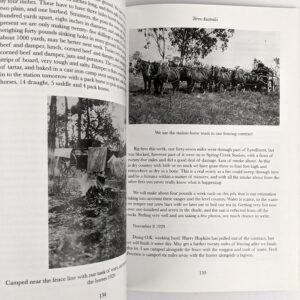
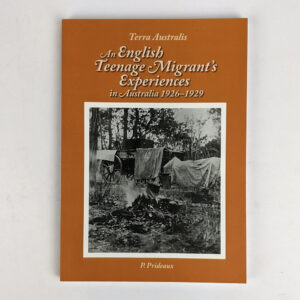
Terra Australis: An English Teenage Migrant’s Experiences in Australia, 1926-1929
AU$30.00 Read MoreAdd to cartP. Prideaux
Mackay: Nindaroo Publishing Australia, 2022.A snapshot of daily life on outback properties in New South Wales and Queensland, 1925-29 told through a young man’s letters to his mother.
-

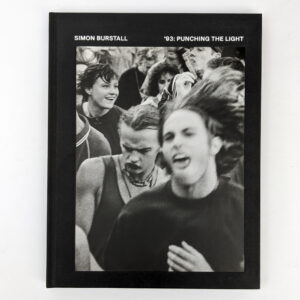
’93: Punching the Light
AU$300.00 Read MoreAdd to cartSimon Burstall
[Bologna]: Damiani, 2019.Photo documentation of the early 90s underground rave subsculture in Sydney, Australia, captured by the then 17 year old Simon Burstall.
-
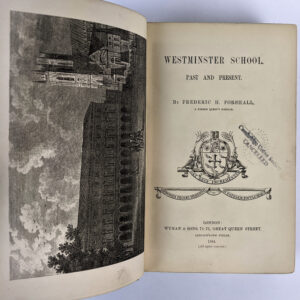
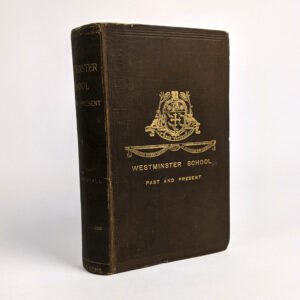
Westminster School: Past and Present
AU$1,200.00 Read MoreAdd to cartFrederic H. Forshall
London: Wyman & Sons, 1884.A history of the Westminster School in London, though also a recording of its past customs and a lengthy biographical recording of headmasters and numerous distinguished students, and personal reminiscences. Frederic H. Forshall was a Queen’s Scholar at Westminster and won a scholarship to Trinity College, Cambridge, but left after a year, moving to Sydney. He was part of the first cohort at The University of Sydney in 1852, and while still a student was appointed the University Librarian. In 1853 he was the first prizewinner for Greek verse composition which are printed here (pp. 358-360). Plates illustrating various interiors, Westminster beating Eton at rowing in 1845, and others.
-
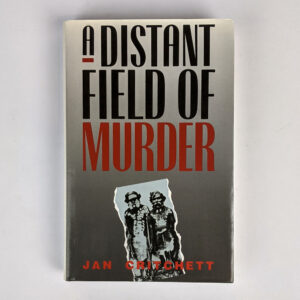
A Distant Field of Murder: Western District Frontiers, 1834-1848
AU$150.00 Read MoreAdd to cartJan Critchett
Melbourne: Melbourne University Press, 1990. -
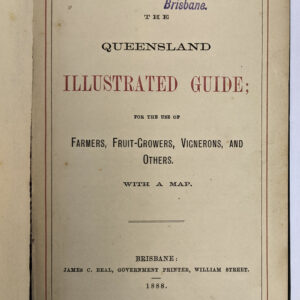
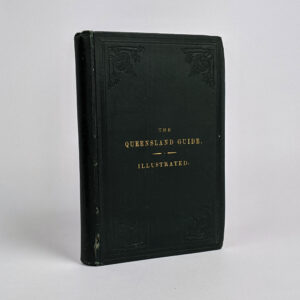
The Queensland Illustrated Guide; for the use of Farmers, Fruit-Growers, Vignerons, and Others
AU$500.00 Read MoreAdd to cart[Alfred Midgley]
Brisbane: James C. Beal, Government Printer, 1888.Distributed in Great Britain to promote emigration to Queensland in the late 19th century. The 9 original photographs by prominent studio Poul C. Poulson. Includes folding Map of Queensland Shewing Land Agents Districts in rear pocket. FERGUSON 12573. This copy signed by the Under Secretary for Agriculture and with the stamp of the Department of Agriculture, Brisbane.
-
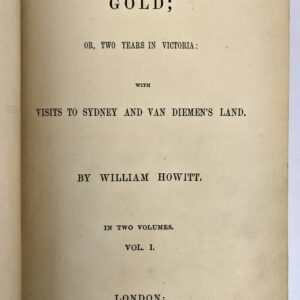
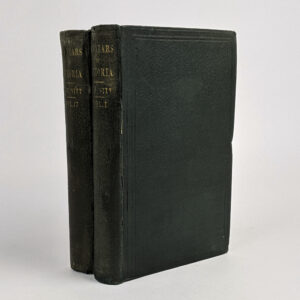
Land, Labour, and Gold; or, Two Years in Victoria: with Visits to Sydney and Van Diemen’s Land
AU$800.00 Read MoreAdd to cart[Alfred] William Howitt
London: Longman, Brown, Green, and Longmans, 1855.The sought after first edition in original cloth of one of the classic Australian gold digger narratives. FERGUSON 10618, WANTRUP (2023) 415 with the Westley’s binder’s ticket, and the advertisments as identified in (a). Minor splitting to joints, a small chip to the backstrip of of Vol.1. Upper hinge of volume 1 cracked. Bookseller’s stamp of R. Burge, Manchester. Minor tanning and wear to interior.
-
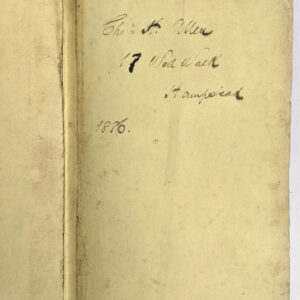
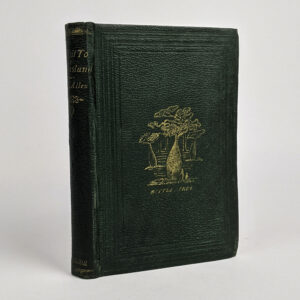
A Visit to Queensland and Her Goldfields
AU$1,500.00 Read MoreAdd to cartChas. H. Allen
London: Chapman and Hall, 1870.A memoir of the Queensland goldfields by English painter and traveller Charles H. Allen (1824-1904) during his time in in Queensland in 1868. This copy inscribed by the author to his son, Charles Mansfield Allen, additionally autographed with his name and address to the front endpaper.
-
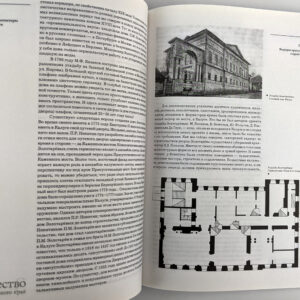
![[Architecture of the Kaluga Region: From Antiquity to the Present Day]](https://www.thebookmerchantjenkins.com/wp-content/uploads/0033374-300x300.jpg)
[Architecture of the Kaluga Region: From Antiquity to the Present Day]
AU$100.00 Read MoreAdd to cartA. C. Dneprovskiy-Orbeliani
Kaluga: N. F. Bochkareva, 2006. -
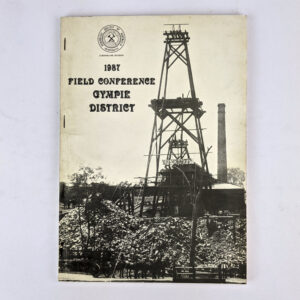
1987 Field Conference: Gympie District
AU$60.00 Read MoreAdd to cartC. G. Murray; J. B. Waterhouse
Brisbane: Geological Society of Australia, Queensland Division, 1987. -
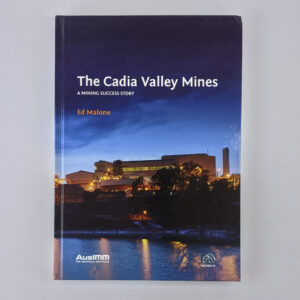
The Cadia Valley Mines: A Mining Success Story
AU$50.00 Read MoreAdd to cartEd Malone
Melbourne: The Australasian Institute of Mining and Metallurgy, 2011.7 page Appendix laid in.
-
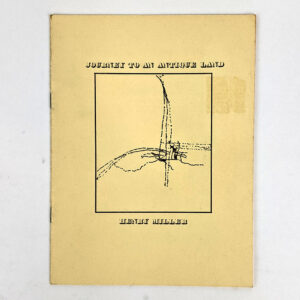
Journey To An Antique Land
AU$20.00 Read MoreAdd to cartHenry Miller
London: Village Press, 1973.A travel sketch of St. Remy, in the south of France, by Henry Miller and his impressions of the ruins of the Greco-Roman settlement, Glanum.
-

T*
AU$50.00 Read MoreAdd to cartGiordano Bonora
Milan: Mousse Publishing, 2019.“This book is inspired by the pictures that Giordano Bonora, a young streetcar operator and aspiring photographer, took of Bolognas small transgender community in 1980 (although it would be more correct to speak, in this case, of proto-Transgenderism). Reproduced here for the first time, these raw and gilded images reflect–during a period in Italy characterized by subversive movements and political revolts that were not just rooted in questions of identity–attempts made by T* people at a construction of the self outside the binary logic of the genotypically XY male/genotypically XX female.” (publisher’s blurb) This copy in the publisher’s plastic wrap.
-
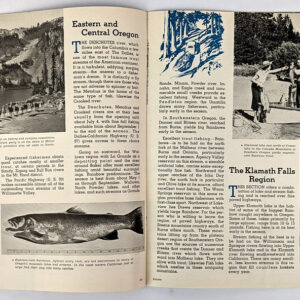
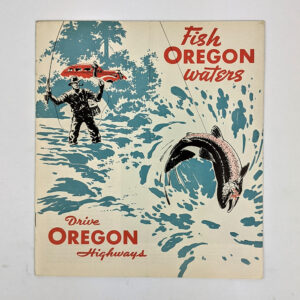
Fish Oregon Waters, Drive Oregon Highways
AU$60.00 Read MoreAdd to cartTravel and Information Department of the Oregon State Highway Commission
Salem: Travel and Information Department of the Oregon State Highway Commission, No date.1930s fishing travel guide to Oregon.
